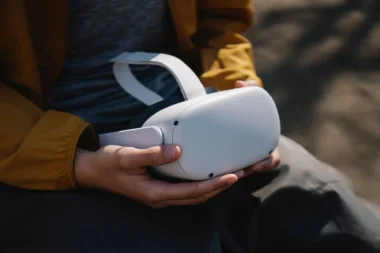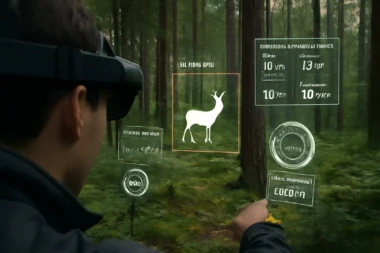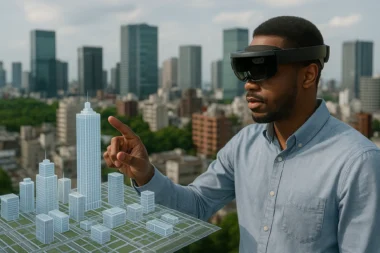Introduction to Neurable:
In recent years, virtual reality (VR) has emerged as a rapidly evolving technology, enabling users to immerse themselves in realistic and interactive virtual environments. While VR has made significant strides in visual and auditory experiences, one critical aspect that still poses challenges is user input and control. This is where Neurable, a cutting-edge company specializing in brain-computer interface (BCI) technology, steps in. Neurable’s innovative approach leverages the power of the human brain to bridge the gap between the physical and virtual worlds, creating a genuinely mind-blowing VR experience.
How Brain-Computer Interface Technology for Virtual Reality Works:
Neurable’s BCI technology offers a groundbreaking solution by allowing users to interact with virtual environments using their thoughts, revolutionizing how we interface with technology. This novel approach holds tremendous potential for entertainment, gaming, and various industries such as healthcare, education, and training simulations.
The foundation of Neurable’s technology lies in electroencephalography (EEG), a non-invasive method of recording electrical brain activity through sensors placed on the scalp. By detecting and analyzing the brain’s electrical signals, Neurable’s system translates the user’s intentions and commands into actionable inputs within the virtual world.
Let’s delve into the key components and working principles of Neurable’s brain-computer interface technology for virtual reality:
1. EEG Acquisition: Neurable employs a high-density EEG headset with multiple electrodes to capture the user’s brain activity. These electrodes pick up electrical signals generated by neurons firing in specific brain regions.
2. Signal processing: Neurable’s sophisticated algorithms perform real-time signal processing and analysis using the raw EEG data the headset collects. These algorithms identify patterns and signatures associated with specific mental states or intentions.
3. Intent Detection and Classification: Using machine learning and artificial intelligence techniques, Neurable’s system classifies the user’s intentions based on the EEG data. This involves training the algorithms to recognize patterns corresponding to different mental states or commands.
4. Mapping Intent to Virtual Actions: Neurable’s technology maps it to specific actions within the virtual environment once the user’s intention is determined. For example, the system can interpret the user’s intent to move forward, select an object, or perform a specific task.
5. Seamless Integration with VR Systems: Neurable’s BCI technology seamlessly integrates with existing VR hardware and software platforms. The translated intent commands are then communicated to the VR system, enabling real-time interaction and control.
Framework:
Neurable’s BCI framework comprises several components that enable seamless interaction between the human brain and virtual reality environments. The critical features of their framework include:
1. Electroencephalography (EEG) Headset: Neurable utilizes a high-density EEG headset with multiple electrodes to capture electrical brain activity. This non-invasive device records the brain’s electrical signals and sends them for further processing and analysis.
2. Signal processing and analysis: Using sophisticated algorithms, the headset processes and studies the raw EEG data in real time. This stage involves extracting relevant features from the EEG signals and transforming them into meaningful information about the user’s intentions and mental states.
3. Machine Learning and Artificial Intelligence: Neurable leverages machine learning and artificial intelligence techniques to train algorithms. By using large datasets of EEG data collected during various mental states and intentions, the algorithms learn to recognize patterns and make accurate predictions.
4. Intent Classification and Mapping: Once the relevant features are extracted, and the algorithms are trained, Neurable’s system classifies the user’s intentions based on the EEG data. This classification involves mapping specific EEG patterns to intended actions or commands within the virtual environment.
5. Integration with Virtual Reality Systems: Neurables integrates their BCI technology with existing virtual reality hardware and software platforms. The translated intent commands are then communicated to the VR system, allowing real-time interaction and control.
Principles:
Neurable’s BCI technology operates based on several fundamental principles:
1. Neuroplasticity: The brain can adapt and rewire based on experience and training. Neurable’s technology leverages this principle to enable users to learn and control virtual environments using their thoughts.
2. Mental State Recognition: Neurable’s algorithms are designed to recognize specific mental states or intentions based on EEG patterns. The system can accurately interpret the user’s desired commands by detecting patterns associated with actions like movement or object selection.
3. Real-time Feedback: Neurable’s BCI system provides real-time feedback to the user, allowing them to understand and adjust their mental states or intentions to achieve the desired virtual actions. This feedback loop enhances the user’s ability to control the virtual environment effectively.
Algorithms:
Neurable employs signal processing techniques, machine learning algorithms, and artificial intelligence to enable accurate intent detection and classification. Although Neurable’s specific algorithms may not be available to the public, they probably use the following strategies:
1. Feature Extraction: Neurable’s algorithms extract relevant features from the EEG signals, such as frequency bands, power spectral density, or event-related potentials. These features capture the distinct patterns associated with different mental states or intentions.
2. Classification Algorithms: Neurable utilizes machine learning algorithms, such as support vector machines (SVM), artificial neural networks (ANN), or deep learning models, to classify the user’s intentions based on the extracted features. These algorithms are trained on labeled datasets to recognize patterns and make accurate predictions.
3. Adaptive Learning: Neurable’s algorithms may incorporate adaptive learning techniques, allowing the system to adapt and refine its classification models based on user-specific data. This adaptive approach enhances the system’s accuracy and responsiveness over time.
Benefits and Applications:
Neurable’s brain-computer interface technology opens up a multitude of possibilities in the realm of virtual reality. Here are some key benefits and applications:
1. Enhanced Immersion: By enabling direct brain control, Neurable’s technology eliminates the need for conventional controllers, resulting in a more immersive and natural VR experience. Users can navigate, interact with, and manipulate virtual objects through their thoughts.
2. Accessibility and Inclusivity: BCI technology allows individuals with physical disabilities or impairments to access and enjoy VR experiences without relying on manual dexterity. This breakthrough has the potential to significantly enhance accessibility and inclusivity in the gaming and entertainment industries.
3. Healthcare and Rehabilitation: Neurable technology holds great promise in healthcare settings, facilitating rehabilitation and therapy for patients with neurological conditions or injuries. VR-based neurorehabilitation programs can be personalized based on the patient’s cognitive state and progress.
4. Training and Simulation: Various industries, including aviation, military, and sports, can leverage Neurable’s BCI technology to create realistic training simulations. This allows users to practice complex tasks and decision-making in safe virtual environments while monitoring their cognitive responses.
Conclusion:
Neurable’s brain-computer interface technology represents a remarkable leap forward in virtual reality. By harnessing the power of the human brain, Neurable has unlocked new avenues for immersive experiences, accessibility, healthcare applications, and training simulations. As technology advances, it holds tremendous potential to reshape the way we interact with virtual environments, offering a glimpse into a future where our thoughts seamlessly connect us with digital realms.



